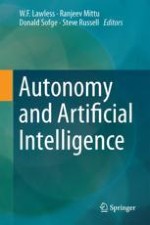2017 | OriginalPaper | Chapter
10. Semantic Vector Spaces for Broadening Consideration of Consequences
Author : Douglas Summers-Stay
Published in: Autonomy and Artificial Intelligence: A Threat or Savior?
Publisher: Springer International Publishing
Activate our intelligent search to find suitable subject content or patents.
Select sections of text to find matching patents with Artificial Intelligence. powered by
Select sections of text to find additional relevant content using AI-assisted search. powered by
